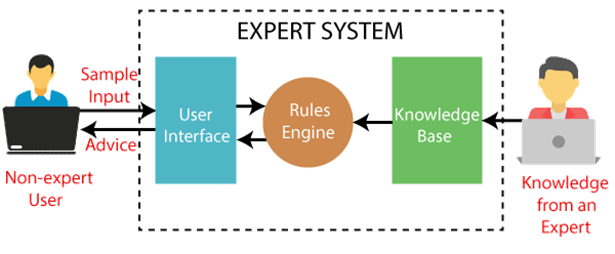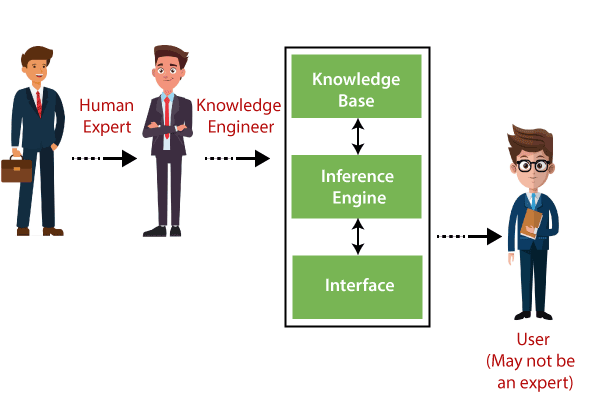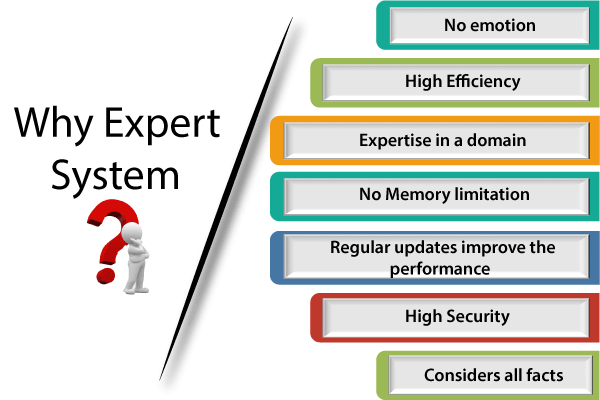An expert system is a computer program that is designed to solve complex problems and to provide decision-making ability like a human expert. It performs this by extracting knowledge from its knowledge base using the reasoning and inference rules according to the user queries.
The expert system is a part of AI, and the first ES was developed in the year 1970, which was the first successful approach of artificial intelligence. It solves the most complex issue as an expert by extracting the knowledge stored in its knowledge base. The system helps in decision making for compsex problems using both facts and heuristics like a human expert. It is called so because it contains the expert knowledge of a specific domain and can solve any complex problem of that particular domain. These systems are designed for a specific domain, such as medicine, science, etc.
The performance of an expert system is based on the expert's knowledge stored in its knowledge base. The more knowledge stored in the KB, the more that system improves its performance. One of the common examples of an ES is a suggestion of spelling errors while typing in the Google search box.
Below is the block diagram that represents the working of an expert system:

Note: It is important to remember that an expert system is not used to replace the human experts; instead, it is used to assist the human in making a complex decision. These systems do not have human capabilities of thinking and work on the basis of the knowledge base of the particular domain.
Below are some popular examples of the Expert System:
- DENDRAL: It was an artificial intelligence project that was made as a chemical analysis expert system. It was used in organic chemistry to detect unknown organic molecules with the help of their mass spectra and knowledge base of chemistry.
- MYCIN: It was one of the earliest backward chaining expert systems that was designed to find the bacteria causing infections like bacteraemia and meningitis. It was also used for the recommendation of antibiotics and the diagnosis of blood clotting diseases.
- PXDES: It is an expert system that is used to determine the type and level of lung cancer. To determine the disease, it takes a picture from the upper body, which looks like the shadow. This shadow identifies the type and degree of harm.
- CaDeT: The CaDet expert system is a diagnostic support system that can detect cancer at early stages.
Characteristics of Expert System
- High Performance: The expert system provides high performance for solving any type of complex problem of a specific domain with high efficiency and accuracy.
- Understandable: It responds in a way that can be easily understandable by the user. It can take input in human language and provides the output in the same way.
- Reliable: It is much reliable for generating an efficient and accurate output.
- Highly responsive: ES provides the result for any complex query within a very short period of time.
Components of Expert System
An expert system mainly consists of three components:
- User Interface
- Inference Engine
- Knowledge Base

1. User Interface
With the help of a user interface, the expert system interacts with the user, takes queries as an input in a readable format, and passes it to the inference engine. After getting the response from the inference engine, it displays the output to the user. In other words, it is an interface that helps a non-expert user to communicate with the expert system to find a solution.
2. Inference Engine(Rules of Engine)
- The inference engine is known as the brain of the expert system as it is the main processing unit of the system. It applies inference rules to the knowledge base to derive a conclusion or deduce new information. It helps in deriving an error-free solution of queries asked by the user.
- With the help of an inference engine, the system extracts the knowledge from the knowledge base.
- There are two types of inference engine:
- Deterministic Inference engine: The conclusions drawn from this type of inference engine are assumed to be true. It is based on facts and rules.
- Probabilistic Inference engine: This type of inference engine contains uncertainty in conclusions, and based on the probability.
Inference engine uses the below modes to derive the solutions:
- Forward Chaining: It starts from the known facts and rules, and applies the inference rules to add their conclusion to the known facts.
- Backward Chaining: It is a backward reasoning method that starts from the goal and works backward to prove the known facts.
3. Knowledge Base
- The knowledgebase is a type of storage that stores knowledge acquired from the different experts of the particular domain. It is considered as big storage of knowledge. The more the knowledge base, the more precise will be the Expert System.
- It is similar to a database that contains information and rules of a particular domain or subject.
- One can also view the knowledge base as collections of objects and their attributes. Such as a Lion is an object and its attributes are it is a mammal, it is not a domestic animal, etc.
Components of Knowledge Base
- Factual Knowledge: The knowledge which is based on facts and accepted by knowledge engineers comes under factual knowledge.
- Heuristic Knowledge: This knowledge is based on practice, the ability to guess, evaluation, and experiences.
Knowledge Representation: It is used to formalize the knowledge stored in the knowledge base using the If-else rules.
Knowledge Acquisitions: It is the process of extracting, organizing, and structuring the domain knowledge, specifying the rules to acquire the knowledge from various experts, and store that knowledge into the knowledge base.
Development of Expert System
Here, we will explain the working of an expert system by taking an example of MYCIN ES. Below are some steps to build an MYCIN:
- Firstly, ES should be fed with expert knowledge. In the case of MYCIN, human experts specialized in the medical field of bacterial infection, provide information about the causes, symptoms, and other knowledge in that domain.
- The KB of the MYCIN is updated successfully. In order to test it, the doctor provides a new problem to it. The problem is to identify the presence of the bacteria by inputting the details of a patient, including the symptoms, current condition, and medical history.
- The ES will need a questionnaire to be filled by the patient to know the general information about the patient, such as gender, age, etc.
- Now the system has collected all the information, so it will find the solution for the problem by applying if-then rules using the inference engine and using the facts stored within the KB.
- In the end, it will provide a response to the patient by using the user interface.
Participants in the development of Expert System
There are three primary participants in the building of Expert System:
- Expert: The success of an ES much depends on the knowledge provided by human experts. These experts are those persons who are specialized in that specific domain.
- Knowledge Engineer: Knowledge engineer is the person who gathers the knowledge from the domain experts and then codifies that knowledge to the system according to the formalism.
- End-User: This is a particular person or a group of people who may not be experts, and working on the expert system needs the solution or advice for his queries, which are complex.
Why Expert System?

Before using any technology, we must have an idea about why to use that technology and hence the same for the ES. Although we have human experts in every field, then what is the need to develop a computer-based system. So below are the points that are describing the need of the ES:
- No memory Limitations: It can store as much data as required and can memorize it at the time of its application. But for human experts, there are some limitations to memorize all things at every time.
- High Efficiency: If the knowledge base is updated with the correct knowledge, then it provides a highly efficient output, which may not be possible for a human.
- Expertise in a domain: There are lots of human experts in each domain, and they all have different skills, different experiences, and different skills, so it is not easy to get a final output for the query. But if we put the knowledge gained from human experts into the expert system, then it provides an efficient output by mixing all the facts and knowledge
- Not affected by emotions: These systems are not affected by human emotions such as fatigue, anger, depression, anxiety, etc.. Hence the performance remains constant.
- High security: These systems provide high security to resolve any query.
- Considers all the facts: To respond to any query, it checks and considers all the available facts and provides the result accordingly. But it is possible that a human expert may not consider some facts due to any reason.
- Regular updates improve the performance: If there is an issue in the result provided by the expert systems, we can improve the performance of the system by updating the knowledge base.
Capabilities of the Expert System
Below are some capabilities of an Expert System:
- Advising: It is capable of advising the human being for the query of any domain from the particular ES.
- Provide decision-making capabilities: It provides the capability of decision making in any domain, such as for making any financial decision, decisions in medical science, etc.
- Demonstrate a device: It is capable of demonstrating any new products such as its features, specifications, how to use that product, etc.
- Problem-solving: It has problem-solving capabilities.
- Explaining a problem: It is also capable of providing a detailed description of an input problem.
- Interpreting the input: It is capable of interpreting the input given by the user.
- Predicting results: It can be used for the prediction of a result.
- Diagnosis: An ES designed for the medical field is capable of diagnosing a disease without using multiple components as it already contains various inbuilt medical tools.
Advantages of Expert System
- These systems are highly reproducible.
- They can be used for risky places where the human presence is not safe.
- Error possibilities are less if the KB contains correct knowledge.
- The performance of these systems remains steady as it is not affected by emotions, tension, or fatigue.
- They provide a very high speed to respond to a particular query.
Limitations of Expert System
- The response of the expert system may get wrong if the knowledge base contains the wrong information.
- Like a human being, it cannot produce a creative output for different scenarios.
- Its maintenance and development costs are very high.
- Knowledge acquisition for designing is much difficult.
- For each domain, we require a specific ES, which is one of the big limitations.
- It cannot learn from itself and hence requires manual updates.
Applications of Expert System
- In designing and manufacturing domain
It can be broadly used for designing and manufacturing physical devices such as camera lenses and automobiles. - In the knowledge domain
These systems are primarily used for publishing the relevant knowledge to the users. The two popular ES used for this domain is an advisor and a tax advisor. - In the finance domain
In the finance industries, it is used to detect any type of possible fraud, suspicious activity, and advise bankers that if they should provide loans for business or not. - In the diagnosis and troubleshooting of devices
In medical diagnosis, the ES system is used, and it was the first area where these systems were used. - Planning and Scheduling
The expert systems can also be used for planning and scheduling some particular tasks for achieving the goal of that task.
Comments
Post a Comment